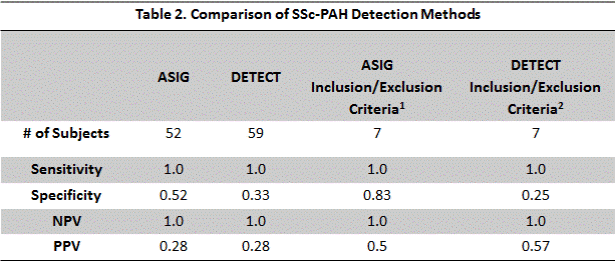Session Information
Session Type: ACR Poster Session A
Session Time: 9:00AM-11:00AM
Background/Purpose: Pulmonary arterial hypertension (PAH) is one of the leading causes of mortality in patients with systemic sclerosis (SSc). Active screening detects SSc-PAH earlier and may improve survival. Our objective was to evaluate the predictive accuracy of 2012 Australian Scleroderma Interest Group (ASIG) and 2013 DETECT when applied to all patients with SSc with suspected pulmonary hypertension (PH) versus application to only those patients with SSc with suspected PH who met the published inclusion/exclusion criteria for ASIG and DETECT (Table 1).
Methods: Subjects with a diagnosis of SSc based on 2013 ACR/EULAR classification criteria with suspected PH based on the 2013 recommendations for screening and detection of connective tissue disease (CTD)-associated PAH undergoing right heart catheterization (RHC) were evaluated (Khanna et al. Arth Rheum. 2013). Those with non-PH or PAH on RHC had ASIG and DETECT applied. Contingency table analysis was used to evaluate sensitivity, specificity, negative predictive value (NPV), and positive predictive value (PPV).
Results: Approximately 281 subjects underwent screening for PH, and out of those 281 subjects, 113 subjects underwent RHC based on 2013 recommendations for CTD-PAH or clinical opinion of the referring physician (Figure 1). The prevalence of PAH was 17% (Figure 1). DETECT and ASIG performed similarly with 100% sensitivity and NPV in subjects who met and who did not meet the inclusion/exclusion criteria for ASIG or DETECT (Table 2). However, only approximately 10% of subjects met the original published inclusion/exclusion criteria. The most common reason for not meeting the inclusion/exclusion criteria was a higher DLco value; during ASIG application, 36 subjects did not have a DLco ˂ 50 % predicted and during DETECT application, 29 subjects did not have a DLco ˂ 60 % predicted.
Conclusion: In a well-defined SSc- PH cohort, ASIG and DETECT work well as screening tools when applied to a broad population of subjects with SSc. If only the published inclusion/exclusion criteria for ASIG AND DETECT are used, a large proportion of subjects (87 to 88%) with suspected PH would have been missed.
To cite this abstract in AMA style:
Young A, Moles V, Nagaraja V, Visovatti SH, McLaughlin V, Khanna D. A Small Proportion of Patients with Systemic Sclerosis with Suspected Pulmonary Hypertension Meet the Published Inclusion/Exclusion Criteria for Two Systemic Sclerosis Associated Pulmonary Arterial Hypertension Screening Algorithms– Results from a Single Center Cohort [abstract]. Arthritis Rheumatol. 2016; 68 (suppl 10). https://acrabstracts.org/abstract/a-small-proportion-of-patients-with-systemic-sclerosis-with-suspected-pulmonary-hypertension-meet-the-published-inclusionexclusion-criteria-for-two-systemic-sclerosis-associated-pulmonary-a/. Accessed .« Back to 2016 ACR/ARHP Annual Meeting
ACR Meeting Abstracts - https://acrabstracts.org/abstract/a-small-proportion-of-patients-with-systemic-sclerosis-with-suspected-pulmonary-hypertension-meet-the-published-inclusionexclusion-criteria-for-two-systemic-sclerosis-associated-pulmonary-a/



